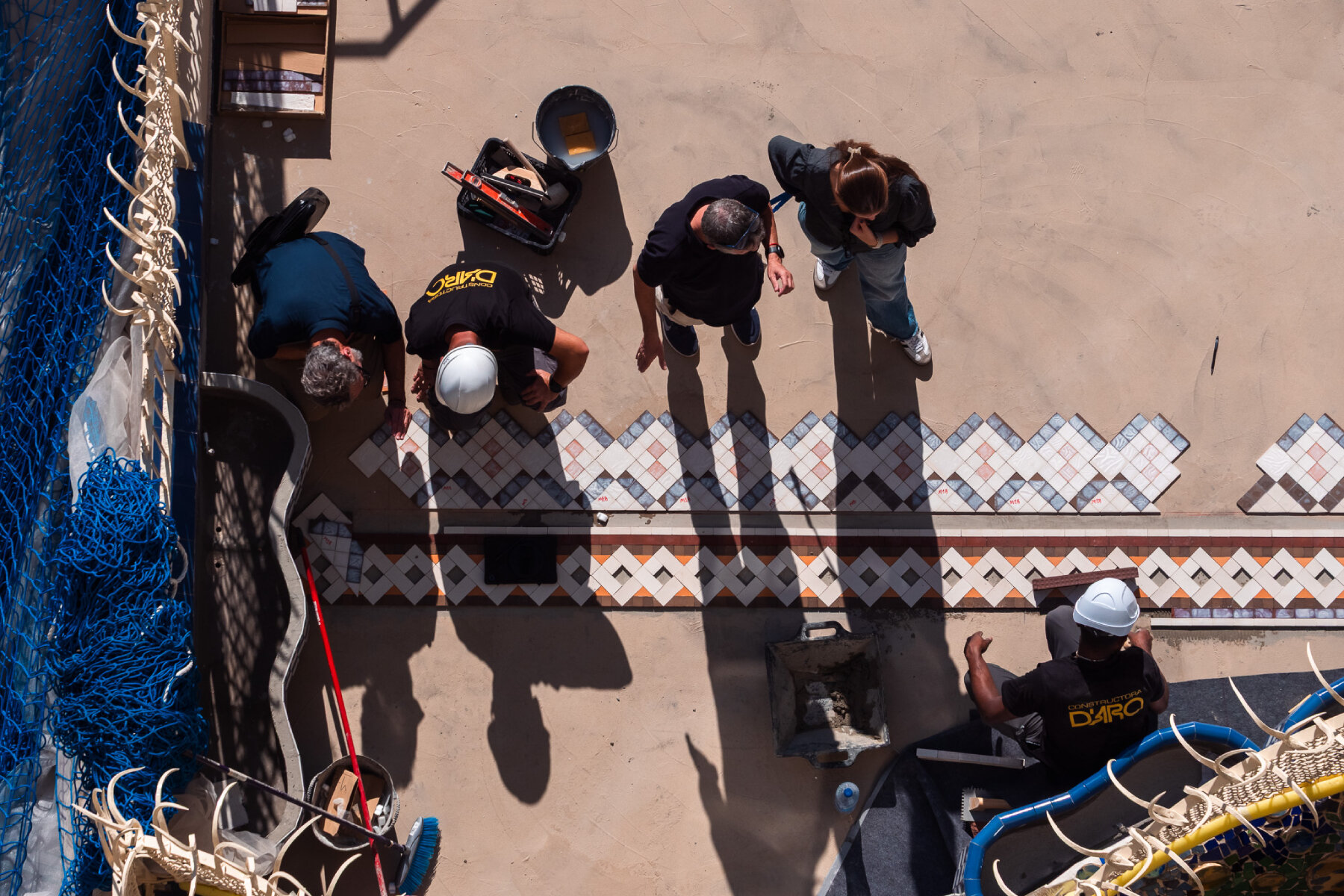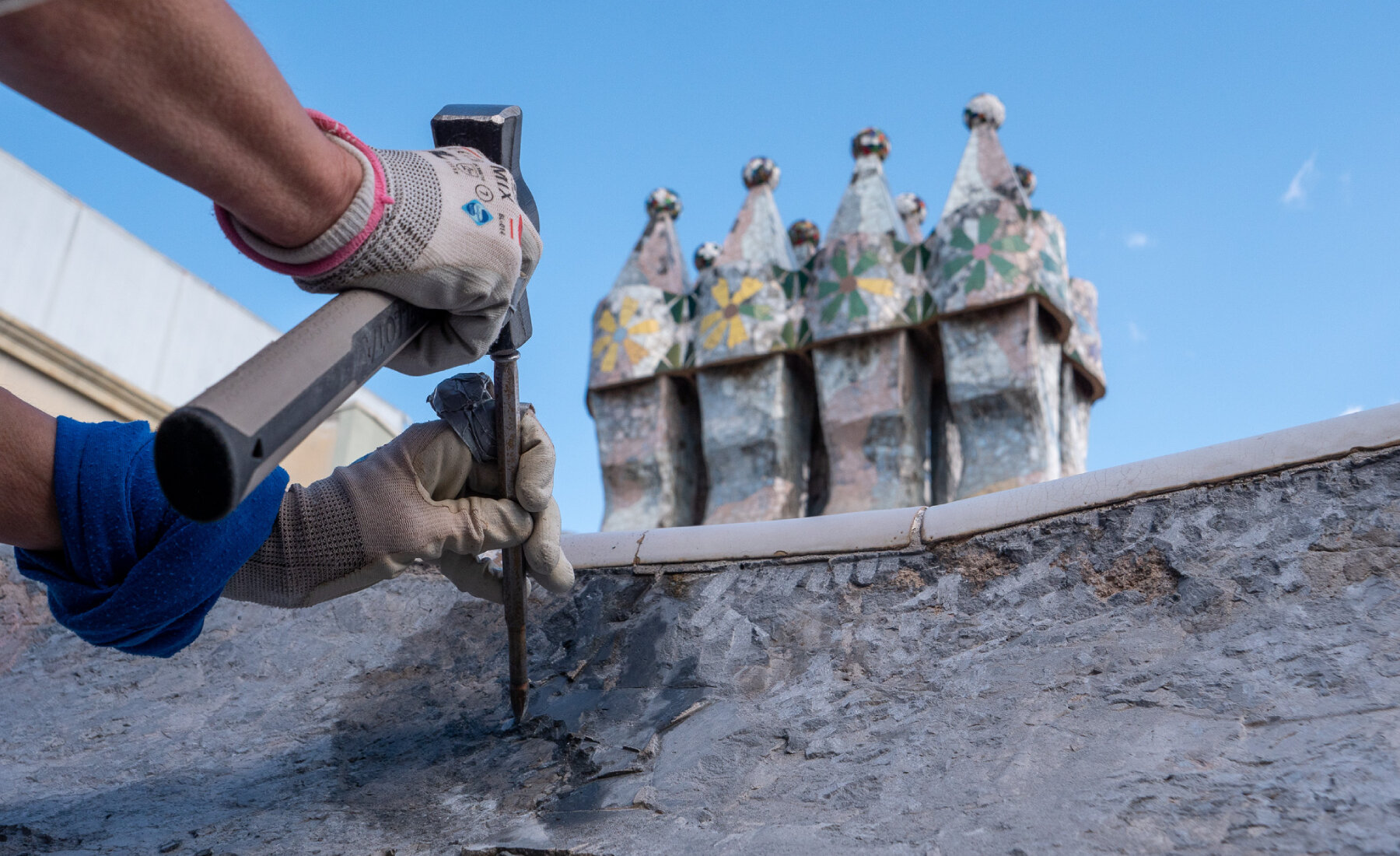revitalizing one of antoni Gaudí’s most emblematic works
Casa Batlló, one of Antoni Gaudí’s most emblematic residential works, has been undergoing an ambitious process of restoration over the past year, led by architect Xavier Villanueva. The project, now set to open to the public on June 19th, focuses on returning the vivid intricacy of the building’s rear facade, private courtyard, and garden to their original condition as first designed in 1906. This period marked Gaudí’s mature phase within the Catalan modernisme movement in which he began synthesizing structural experimentation, ornamental craft, and spatial poetry into unified architectural compositions.
Over the years, the iconic dragon-scaled elevation has continued to draw crowds as it animates the Passeig de Gràcia in Barcelona, while also becoming a platform for key cultural initiatives, from Sofia Crespo’s projection-mapped facade to Kengo Kuma’s shimmering staircase and Refik Anadol’s digital interventions. While that elevation has evolved into an icon of modern Barcelona, the lesser-seen rear facade remained largely hidden from view as its character gradually faded with time and became obscured by later additions over the past century. Now, as Casa Batlló marks 20 years as a UNESCO World Heritage Site, the concealed domestic spaces are set to reemerge with the clarity and vibrancy Gaudí intended.
Restoration teams uncovered the original hues of the stucco, ironwork, and carpentry hidden beneath layers of pale repainting, while discovering previously unseen spatial and structural features such as a spiral-shaped vaulted support system of brick and iron beneath the balconies. Mosaic patterns, parabolic pergolas, handcrafted planters, and original Nolla tilework were also reassembled with the help of skilled artisans, bringing back texture, rhythm, and intention. ‘When we discovered the original colors, we couldn’t believe it, The facade as it stands is now like the photographic negative of the original by Gaudi,’ says Villanueva. ‘The discoveries we made relate in shapes, colors, and materials to the rest of Casa Batlló.’

pergola after restoration | image © Claudia Mauriño
hidden Color, craftsmanship, & structure return to Casa Batlló
Casa Batlló was designed as a private garden space for the Batlló family, and its courtyard was conceived as a place of retreat from the city’s bustle, amid tiled paths, parabolic pergolas, and handmade planters. This restoration is the first full intervention on the courtyard and back facade since its completion, recovering lost elements while reinterpreting them through an exacting study of archival drawings and photographs, stratigraphic testing, and material research.
The interventions seem to foster a dialogue between the building’s past and present through a particular focus on materiality. Over 85,000 pieces of Nolla mosaic, originally laid at the start of the nineteenth century in the courtyard, have been restored or replicated by hand, using enhanced materials to ensure durability outdoors. The trencadís mosaics, Antoni Gaudí’s signature patchwork of ceramics and glass, were largely preserved in situ where possible, or carefully reproduced using 3D scans and high-resolution archival imagery, keeping their original patterns intact.

facade after restoration | image © Claudia Mauriño
Ironwork, including railings and pergola structures, has been restored by Enric Pla Montferrer’s workshop in Alpens. Where previous repairs had introduced welds, the team reinstated Gaudí’s original bolted modular system that was discovered thanks to original construction markings found on site. During the restoration, the team found that even the hidden structure supporting the balconies revealed surprises, such as a spiraling system of brick and reinforced vaults, radical for its time, and undocumented until this recent intervention.
Wooden elements, from the original muntins to balcony doors, were restored or recreated by heritage carpenter Josep Bartolí. Crucially, the original hues — long buried under decades of repainting — were uncovered through stratigraphic analysis, revealing a palette that echoes the green tones of Casa Batlló’s main facade. The stucco too revealed a dramatic shift from a bold black that had faded to a warm cream, reshaping how the entire rear facade is perceived in contrast to the theatrical flourish the building is otherwise celebrated for.

courtyard after restoration | image © Claudia Mauriño
the landmark celebrates 20 years as UNESCO heritage site
For the restoration team, the project forms part of a broader five-year initiative to reframe Casa Batlló as a living cultural space. Now marking its 20th anniversary as a UNESCO World Heritage Site, the building is celebrated as an architectural landmark — a pivotal work within Gaudí’s built legacy — as well as an evolving site of public engagement. This approach stretches the impact of conservation beyond historical fidelity, and considers it in the context of public access, education, and craft.
To realize this vision, the team brought together a multidisciplinary group of artisans including ceramicists, carpenters, ironworkers, and glaziers, who worked collaboratively to recover Gaudí’s original materials and techniques. Their work is being documented and shared through a short film and accompanying on-site exhibitions, allowing visitors to understand the process and labor behind the final restoration. These efforts speak to a broader goal to make the house more accessible and legible, inviting the public into Gaudí’s world by illuminating the layers of experimentation, technique, and creative labor that continue to define it more than a century on.

ironwork after restoration | image © Pere Vives

trencadís after restoration | image © Casa Batlló

mosaic restoration process | image © Casa Batlló

mosaic restoration process | image © Casa Batlló

trencadís restoration process | image © Casa Batlló

ironwork restoration process | image © Óscar Rodbag

trencadís restoration process | image © Casa Batlló
project info:
name: Casa Batlló restoration | @casabatllo
location: Barcelona, Spain
lead restoration architect: Xavier Villanueva
The post mosaics, ironwork, and pergolas of gaudí’s casa batlló in barcelona restored after a century appeared first on designboom | architecture & design magazine.








